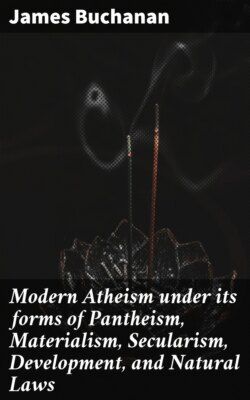Modern Atheism under its forms of Pantheism, Materialism, Secularism, Development, and Natural Laws

Реклама. ООО «ЛитРес», ИНН: 7719571260.
Оглавление
James Buchanan. Modern Atheism under its forms of Pantheism, Materialism, Secularism, Development, and Natural Laws
Modern Atheism under its forms of Pantheism, Materialism, Secularism, Development, and Natural Laws
Table of Contents
INTRODUCTION
FOOTNOTES:
MODERN ATHEISM
CHAPTER I
GENERAL VIEW OF ATHEISM
FOOTNOTES:
CHAPTER II
THEORIES OF DEVELOPMENT
SECTION I
THEORY OF COSMICAL DEVELOPMENT, OR OF THE PRODUCTION OF WORLDS AND PLANETARY SYSTEMS BY NATURAL LAW.—"THE VESTIGES."
SECTION II
THEORY OF PHYSIOLOGICAL DEVELOPMENT; OR THE PRODUCTION OF VEGETABLE AND ANIMAL RACES BY NATURAL LAW.—"TELLIAMED."—PHYSIO-PHILOSOPHY
SECTION III
THEORY OF SOCIAL OR HISTORICAL DEVELOPMENT.—AUGUSTE COMTE
SECTION IV
THEORY OF ECCLESIASTICAL DEVELOPMENT.—J. H. NEWMAN
FOOTNOTES:
CHAPTER III
THEORIES OF PANTHEISM
SECTION I
THE SYSTEM OF SPINOZA
SECTION II
MATERIAL OR HYLOZOIC PANTHEISM
SECTION III
IDEAL PANTHEISM
FOOTNOTES:
CHAPTER IV
THEORIES OF MATERIALISM
SECTION I
DISTINCT FORMS OF MATERIALISM
SECTION II
PROPOSITIONS ON MATERIALISM
SECTION III
THE RELATIONS OF MATERIALISM TO THEOLOGY
FOOTNOTES:
CHAPTER V
THEORY OF GOVERNMENT BY NATURAL LAWS.—VOLNEY.—COMBE
SECTION I
THE DOCTRINE OF NATURAL LAWS AND SECOND CAUSES
SECTION II
THE CONSTITUTION OF MAN CONSIDERED IN ITS RELATION TO THE GOVERNMENT OF GOD
SECTION III
THE EFFICACY OF PRAYER
FOOTNOTES:
CHAPTER VI
THEORIES OF CHANCE AND FATE
FOOTNOTES:
CHAPTER VII
THEORY OF RELIGIOUS LIBERALISM
FOOTNOTES:
CHAPTER VIII
THEORIES OF CERTITUDE AND SKEPTICISM
FOOTNOTES:
CHAPTER IX
THEORY OF SECULARISM.—G. J. HOLYOAKE
FOOTNOTES:
THE END
Отрывок из книги
James Buchanan
Published by Good Press, 2019
.....
It is the more necessary to examine the various forms of this theory, because unquestionably it can appeal to not a few natural analogies, which may serve, on a superficial view, to give it the aspect of verisimilitude. For many of the most signal works of God have been manifestly framed on the principle of gradual growth, and matured by a process of progressive development. We see in the natural world a small seed deposited in the earth, which, under the agency of certain suitable influences, germinates and springs up, producing first a tender shoot, then a stem, and branches, and leaves, and blossoms, and fruit; and every herb or tree, "having seed in itself," makes provision for the repetition of the same process, and the perpetuation and indefinite increase of its kind. The same law is observed in the animal kingdom, where a continuous race is produced from a single pair. And even in the supernatural scheme of Revelation itself, the truth was gradually unfolded in a series of successive dispensations; the First Promise being the germ, which expanded as the Church advanced, until it reached its full development in the Scriptures of the New Testament. These and similar instances may suffice to show that, both in the natural and supernatural Providence of God, He has been pleased to act on the principle of gradual and progressive, as contradistinguished from that of instant and perfect production; and they may seem, at first sight, to afford some natural analogies in favor of the radical idea on which the various modern Theories of Development are based. In such circumstances it would be an unwise and dangerous course either to overlook the palpable facts which Nature and Revelation equally attest, or to deny that they may afford signal manifestations of the manifold wisdom of God. Nor is it necessary for any enlightened advocate of Theism to betake himself to these expedients; he may freely admit the existence of such cases of gradual development, he may even appeal to them as illustrative of the order of Nature, and the design which that order displays; and the only question which he is at all concerned to discuss amounts in substance to this: Whether the method of production which is pursued in the ordinary course of Nature can account for the original commencement of the present system of things?
But the state of the question, and the right application of the argument, may be best illustrated by considering each of the four forms of the theory separately and in succession.
.....